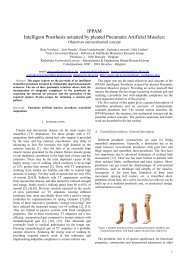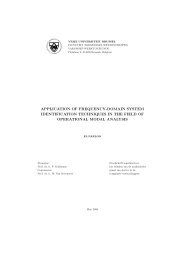VRIJE UNIVERSITEIT BRUSSEL Acoustics - the Dept. of ...
VRIJE UNIVERSITEIT BRUSSEL Acoustics - the Dept. of ...
VRIJE UNIVERSITEIT BRUSSEL Acoustics - the Dept. of ...
You also want an ePaper? Increase the reach of your titles
YUMPU automatically turns print PDFs into web optimized ePapers that Google loves.
3.9. THE INTENSITY METER 51Since <strong>the</strong> intensity is a vectorial quantity is one can determine <strong>the</strong>direction in which <strong>the</strong> intensity is <strong>the</strong> largest. This means <strong>the</strong> intensitymeter can be used to localize sources <strong>of</strong> sound (One can ’scan’ where<strong>the</strong> sound comes from so to speak).It will be shown fur<strong>the</strong>r that <strong>the</strong> intensity meter can also be used tomeasure <strong>the</strong> sound power <strong>of</strong> a source (see <strong>the</strong> next paragraph). For thispurpose <strong>the</strong> intensity meter has a few important advantages :– Thebackground noise canbeeliminated (under <strong>the</strong> conditionthatit is stationary).– Onecandefinearandomsurfacesurrounding<strong>the</strong>source<strong>of</strong>asound(instead <strong>of</strong> a simple spherical surface).– One can measure closer to <strong>the</strong> source (where <strong>the</strong> sound waves arenot necessarily in plane or spherical).There are a few issues that require attention when using an intensitymeter however :Forafixed distance between <strong>the</strong> microphones, <strong>the</strong> intensity meter hasara<strong>the</strong>r limited frequency range where <strong>the</strong> measurements are valid. Theupper limit is given by f U = c (for a distance D = 0.05 this comes4Ddown to f U = 1700). At low frequencies <strong>the</strong> value derived from <strong>the</strong><strong>the</strong>ory is still correct, but noise present in <strong>the</strong> measurement will resultin an incorrect measurement.The direction <strong>of</strong> <strong>the</strong> probe is <strong>of</strong> great importance. To measure <strong>the</strong>power <strong>of</strong> <strong>the</strong> source, <strong>the</strong> intensity probe has to be held perpetual on<strong>the</strong> defined surface at all times (this is not <strong>the</strong> case for an intensitymeter that is not directional).The cost <strong>of</strong> an intensity meter is much higher than that <strong>of</strong> a sonometer.The calibration <strong>of</strong> <strong>the</strong> probe is also a lot more devious (<strong>the</strong> twomicrophones must be matched perfectly.The error on <strong>the</strong> measured intensity depends on <strong>the</strong> distance r between<strong>the</strong> microphones <strong>of</strong> <strong>the</strong> intensity meter and <strong>the</strong> frequency. Assume <strong>the</strong> instantaneouspressure on a certain point in time is given by :p(x) = p m sin(kx) (3.6)with p m <strong>the</strong> amplitude, k <strong>the</strong> wavenumber and x <strong>the</strong> coordinate <strong>of</strong> <strong>the</strong>measured midpoint between <strong>the</strong> microphones. The exact expression for <strong>the</strong>
















